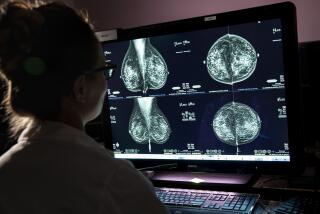Panel recommends blood pressure screening to stop a ‘silent killer’

- Share via
Health authorities in the U.S. are taking fresh aim at a “silent killer” with a recommendation that all American adults be screened for high blood pressure.
People should be screened once a year if they are at least 40 years old, if they are overweight or obese, if they are African American, or if their blood pressure is in the “high normal” range, according to a draft recommendation released Monday by the U.S. Preventive Services Task Force. Adults ages 18 to 39 who have no risk factors for high blood pressure should be screened once every three to five years, the panel said.
In one of the studies cited by the task force, senior citizens in Ontario, Canada, who were randomly assigned to have their blood pressure screened by a pharmacy were less likely than their unscreened counterparts to wind up in a hospital for treatment of a cardiovascular condition. For every 1,000 people who were screened, there were three fewer hospital admissions, researchers found.
An estimated 67 million people in the U.S. have high blood pressure – that’s about 1 out of every 3 adults. But only 47% of them are controlling their blood pressure with medication, according to the Centers for Disease Control and Prevention.
High blood pressure, or hypertension, is much more prevalent in African Americans (42.1%) than in whites (28%), Latinos (26%) or Asian Americans (24.7%). People with the condition are at increased risk of suffering a heart attack or stroke, both leading causes of death in the U.S. They are also more vulnerable to kidney and heart failure. The task force said hypertension caused or contributed to the deaths of at least 362,000 Americans in 2010.
But many people with high blood pressure aren’t even aware that they have it. In most cases, there are no symptoms, though in rare cases it can cause headaches or vomiting, the CDC says. That’s why hypertension is widely known as “the silent killer.”
There are two components of a blood pressure reading. The systolic number, or top number, measures the pressure inside the arteries when the heart muscle contracts; the diastolic number, on the bottom, measures the pressure in the arteries when the muscle is resting between heartbeats.
The task force defined normal blood pressure as anything up to 130/85 mm Hg, although the CDC and the American Heart Assn. use a cutoff of 120/80 mm Hg. People in the range of 130 to 139 mm HG systolic and 88 to 89 mm Hg diastolic were defined as having “high normal blood pressure,” and those exceeding 140/90 mm HG were considered hypertensive. (In February, another panel called the Eighth Joint National Committee on Prevention, Detection, Evaluation and Treatment of High Blood Pressure concluded that the appropriate target for adults ages 60 and older should be 150/90 mm Hg as long as they didn’t have diabetes or chronic kidney disease.)
The task force has endorsed blood pressure screening since 2003, but the new recommendations state that a test in a medical office is only the first step. Studies have found that 5% to 65% of the people who get high blood pressure readings in a doctor’s office turn out not to have high blood pressure when monitored over subsequent days. Some of this is due to a phenomenon known as “white coat syndrome,” in which simply being in a doctor’s office causes one’s blood pressure to rise. This affects an estimated 15% to 30% of Americans, the task force says.
The best way to confirm an initial diagnosis of hypertension is for patients to wear an ambulatory blood pressure monitor for 24 to 48 hours. These monitors automatically take measurements every 20 to 30 minutes as people go about their daily routines and while they’re sleeping, and they provide “the best method for confirming elevated office blood pressure measurements,” the task force said.
Other home blood pressure monitors “may be acceptable,” the task force added, though the evidence of their efficacy is less convincing.
The downsides associated with blood pressure screening are “relatively minor and short-term in nature,” such as the “sleep disturbances, discomfort and restrictions in daily activities” while wearing an ambulatory monitor, the task force said. However, if patients don’t use the monitors to confirm their in-office measurements, they could suffer “more serious harms of unnecessary drug treatment.”
People diagnosed with high blood pressure can usually keep it under control through medication. The first-line drugs include calcium channel blockers (which relax the blood vessels) and the diuretic thiazide. For patients who aren’t African American, the list of initial drugs also includes angiotensin-converting enzyme (ACE) inhibitors and angiotensin receptor blockers (ARBs), although people with chronic kidney disease shouldn’t take both at the same time.
The task force’s recommendation is grade A, which means the panel believes there is “high certainty” that the benefits outweigh the risks. The task force will accept public comments on its proposal until Jan. 26.
For more medical news, follow me on Twitter @LATkarenkaplan and “like” Los Angeles Times Science & Health on Facebook.







